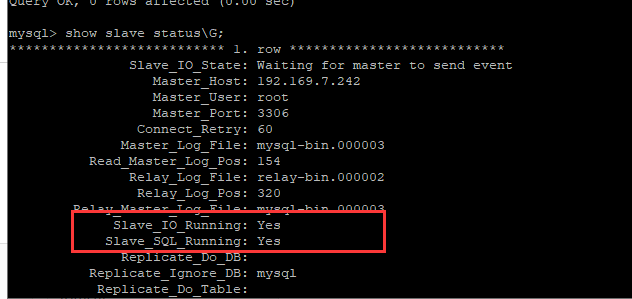Master-1: 192.169.7.242
Master-2: 192.169.0.197
MySQL version: mysql-5.7
1. Modification and description of MySQL configuration file
Modify mysql of the two nodes respectively. Here, modify the configuration file to / etc/my.cnf
Modify Master-1 as follows:
# For advice on how to change settings please see # http://dev.mysql.com/doc/refman/5.6/en/server-configuration-defaults.html # *** DO NOT EDIT THIS FILE. It's a template which will be copied to the # *** default location during install, and will be replaced if you # *** upgrade to a newer version of MySQL. [mysqld] # Remove leading # and set to the amount of RAM for the most important data # cache in MySQL. Start at 70% of total RAM for dedicated server, else 10%. # innodb_buffer_pool_size = 128M # Remove leading # to turn on a very important data integrity option: logging # changes to the binary log between backups. # log_bin # These are commonly set, remove the # and set as required. # basedir = ..... # datadir = ..... # port = ..... # server_id = ..... # socket = ..... # Remove leading # to set options mainly useful for reporting servers. # The server defaults are faster for transactions and fast SELECTs. # Adjust sizes as needed, experiment to find the optimal values. # join_buffer_size = 128M # sort_buffer_size = 2M # read_rnd_buffer_size = 2M sql_mode=NO_ENGINE_SUBSTITUTION,STRICT_TRANS_TABLES server-id=1 #Unique identification of server auto_increment_offset=1 #Starting value of self increasing id auto_increment_increment=2 #Self increasing number per time log-bin = mysql-bin #Open binary function, MASTER master MASTER server must open this item max_binlog_size=1024M #binlog single file maximum binlog_format=mixed #Specify the format of mysql's binlog log, mixed mode relay-log=relay-bin #Turn on the relay log function relay-log-index=slave-relay-bin.index #Relay log list replicate-ignore-db = mysql #Ignore unsynchronized master slave database replicate-ignore-db = information_schema replicate-ignore-db = performance_schema replicate-ignore-db = test
Modify Master-2 as follows:
# For advice on how to change settings please see # http://dev.mysql.com/doc/refman/5.6/en/server-configuration-defaults.html # *** DO NOT EDIT THIS FILE. It's a template which will be copied to the # *** default location during install, and will be replaced if you # *** upgrade to a newer version of MySQL. [mysqld] # Remove leading # and set to the amount of RAM for the most important data # cache in MySQL. Start at 70% of total RAM for dedicated server, else 10%. # innodb_buffer_pool_size = 128M # Remove leading # to turn on a very important data integrity option: logging # changes to the binary log between backups. # log_bin # These are commonly set, remove the # and set as required. # basedir = ..... # datadir = ..... # port = ..... # server_id = ..... # socket = ..... # Remove leading # to set options mainly useful for reporting servers. # The server defaults are faster for transactions and fast SELECTs. # Adjust sizes as needed, experiment to find the optimal values. # join_buffer_size = 128M # sort_buffer_size = 2M # read_rnd_buffer_size = 2M sql_mode=NO_ENGINE_SUBSTITUTION,STRICT_TRANS_TABLES server-id=2 #Unique identification of server auto_increment_offset=2 #Starting value of self increasing id auto_increment_increment=2 #Self increasing number per time log-bin = mysql-bin #Open binary function, MASTER master MASTER server must open this item max_binlog_size=1024M #binlog single file maximum binlog_format=mixed #Specify the format of mysql's binlog log, mixed mode relay-log=relay-bin #Turn on the relay log function relay-log-index=slave-relay-bin.index #Relay log list replicate-ignore-db = mysql #Ignore unsynchronized master slave database replicate-ignore-db = information_schema replicate-ignore-db = performance_schema replicate-ignore-db = test
Be careful:
- The server ID and auto increment offset configurations of Master-1 and Master-2 are different, and the others are the same.
- Server ID: it is the server number. Therefore, the values on the two servers are different. Here they are set as 1 and 2
- Auto increment offset: used to set the value of automatic growth in the database, so as to prevent duplicate fields of sub growth when two sets of external services are provided at the same time
- In my.cnf configuration file, add "binlog? Do? DB = database name" configuration item (multiple can be added) to specify the database to be synchronized. If this configuration item is configured, but the database behind it is not added, binlog does not record its events
2. Restart mysql to make the configuration file effective
Execute the following commands on two nodes respectively:
service mysql stop service mysql start
3. Add master-slave synchronization account
The operation of Master-1 is as follows:
grant replication slave on *.* to 'm1slave'@'172.16.160.37' identified by 'password';
The operation of Master-2 is as follows:
grant replication slave on *.* to 'm2slave'@'172.16.160.35' identified by 'password';
Be careful:
- The IP address in the above SQL statement is the setting of who accesses the local machine, not the local IP address
- If any IP can be accessed by this user, just change the IP address to the percentage sign (%)
4. View the status of Master library
Execute the following commands on two nodes respectively:
show master status;
The results are as follows:
Master-1:

Master-2:

5. Configure synchronization data
The operation of Master-1 is as follows:
change master to master_host='192.169.7.242', master_port=3306, master_user='root', master_password='123456', master_log_file='mysql-bin.000003', master_log_pos=154;
The operation of Master-2 is as follows:
change master to master_host='192.169.0.197', master_port=3306, master_user='root', master_password='123456', master_log_file='mysql-bin.000003', master_log_pos=466;
Be careful:
- The configuration of master log file and master log POS is based on the data queried in step 4
- The configuration of master user and master password is to add the account and password of the role in step 3
6. Run the Slave Library
Execute the following commands on two nodes respectively:
start slave;
7. View the status of the Slave Library
Execute the following commands on two nodes respectively:
show slave status\G;
If the result is as shown in the figure below, it is normal

Reference https://www.jianshu.com/p/58dc118c36ef

